#Canadian expeditionary force
Text

‘The Canadians at Ypres’ by William Barnes-Wollen, 1915. (Image Credit: The Military Museums of Calgary / Public Domain).
31 notes
·
View notes
Text
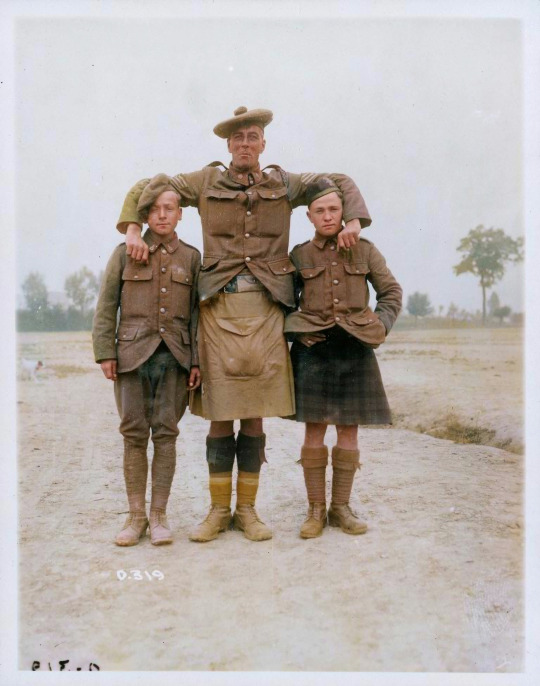
A photographer captured the physical differences among those who formed the Canadian Expeditionary Force. Boys under the age of 18 were allowed to serve in the Canadian Expeditionary Force if they had their parent's permission. Those that did not often lied about their age to enlist in the army.
#CEF#Canadian Expeditionary Force#the great war#the first world war#world war 1#wwi#historical photos#world war one#history#canadian history#1917#ww1#world war 1 stories
70 notes
·
View notes
Text
Exploring The SCP Foundation: SCP-8918 - Death Was Written Large Everywhere
What Is It?
The YouTube video Exploring The SCP Foundation: SCP-8918 – Death Was Written Large Everywhere by the YouTube channel The Exploring Series:
Exploring The SCP Foundation: SCP-8918 – Death Was Written Large Everywhere
Description:
https://scp-wiki.wikidot.com/scp-8918
Written by: Rounderhouse
Support the Patreon to see Exploring videos early and vote on new…

View On WordPress
#Canadian Expeditionary Force#Exploring The SCP Foundation#Exploring The SCP Foundation: SCP-8918 - Death Was Written Large Everywhere#Rounderhouse#SCP#SCP Foundation#SCP-8918#The Exploring Series#Video#War#World War#WWI#YouTube
2 notes
·
View notes
Text
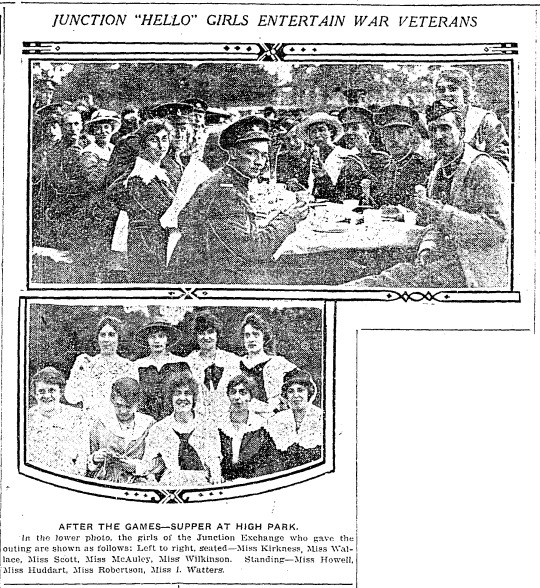
"JUNCTION "HELLO" GIRLS ENTERTAIN WAR VETERANS AFTER THE GAMES-SUPPER AT HIGH PARK," Toronto Star. August 10, 1917. Page 9.
----
In the lower photo, the girls of the Junction Exchange who gave the outing are shown as follows: Left to right, seated-Miss Kirkness, Miss Wallace, Miss Scott, Miss McAuley, Miss Wilkinson. Standing Miss Howell, Miss Huddart, Miss Robertson, Miss I. Watters.
#toronto#the junction#hello girls#entertaining the troops#returned soldiers#canadian veterans#canadian expeditionary force#world war 1#world war 1 canada#home front
2 notes
·
View notes
Text
Not Enough: After fighting the Germans he wanted to fight the Bolsheviks
Not Enough: After fighting the Germans he wanted to fight the Bolsheviks

View On WordPress
#Bolshevik#Canadian Siberian Expeditionary Force#Poland#Russia#St. John New Brunswick#The Bluff#Tuberculosis#YPRES
1 note
·
View note
Text
Frederick Lea Hardy died fighting for Canada at Vimy Ridge in the First World War. Shortly before being killed in action, the teenager spent time in prison doing hard labour as a military punishment for his sexuality.
Hardy was one of at least 19 members of the Canadian Expeditionary Force involved in consensual relationships who were arrested and tried for what was then known as gross indecency.
The painful, often bleak, stories of these men were uncovered by Sarah Worthman while doing research at Veterans Affairs Canada. Her findings have just been published under the auspices of the LGBT Purge Fund, a non-profit organization established through a class-action settlement.
The settlement with Ottawa was a key element of a sweeping federal apology delivered in November 2017 for decades of discrimination against members of the lesbian, gay, bisexual and transgender community. [...]
Continue Reading.
Tagging: @politicsofcanada
268 notes
·
View notes
Note
When you said Jack never came back from World War One, what did you mean? Do different countries have different ability to revive?
I mean it in a poetic way. A running theme in my writing is the facets of humanity lost and found across a life span. I think most people can put flowers on the grave of someone they used to be. Jack's is just somewhat literal.
The usual story is of Gallipoli as a birth of a country the beginning of a national identity. The baptism of blood and fire. There's this construction of a mythos around it for both Australians and New Zealanders. I... Kind of accidentally put that arse over the kettle because it's the place I killed him. There's a quote from Game of Thrones of all places "kill the boy and let the man be born." Anzac Cove, Lone Pine, Quin's Post. These are the places I took him and to a lesser extent Zee, apart.
There's something very sad in the enthusiasm with which the Australians in particular went to war. The western world went to war in 1914 in a storm of hysterical nationalist joy but it always read a bit— more earnest from the Australians. Maybe they were just less subdued than Canadians or Brits or New Zealanders, I don't know. It's a good part imperial delusion but it's not like all of these men were entranced with the imperial project. Men like William Sing and Caleb Shang were a part of the Australian expeditionary forces too.
Jack, as an individual, isn't raised on heroism. He knows what his father is, he knows what soldiers did in his own territory. But there was this glamour to it. This sense of bravery and decency have to exist somewhere and maybe it is on the battlefield. Certainly there are countless stories. They give out medals. In the American part of the anglosphere, courage and bravery are the terms most used but for the Commonwealth, it is gallantry we think of as deserving medals. In effect it means Bravery but also has this connotation of chivalry and decency. He has women in his life who have shaped him as much as the men and rough hewn but honest decency is something he thinks the world needs more of. He thinks war will make more of it. He thinks a kind and spirited boy will become a gallant but fair man.
Instead, his sister buries that boy on a spare bit of the cliff face.
The man who comes back isn't depraved, he's still funny and friendly. But his anger is darker and his optimism is tainted by fatalism. He stops trying on a lot of things. He protests constantly, refuses to play as a team or fight at all sometimes and becomes a bit hedonistic. And misanthropic. So misanthropic. He's always liked animals a bit more than people but oh it got so much worse after WW1.
39 notes
·
View notes
Text
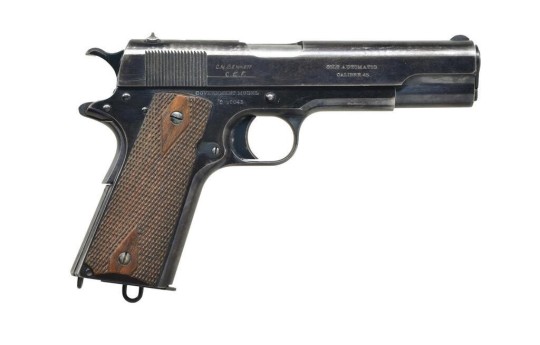
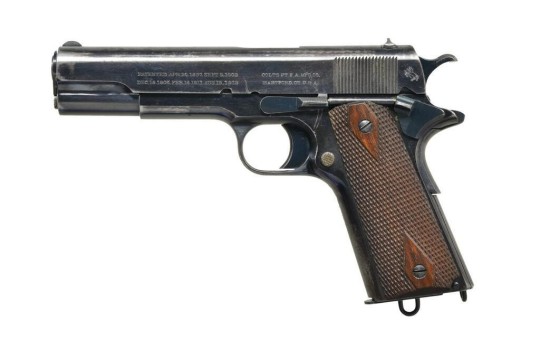
American Colt Model 1911 semi automatic pistol issued to the Canadian Expeditionary Force during World War 1.
from Poulin Antiques
361 notes
·
View notes
Text
Today is the 79th Anniversary of Operation Overlord
On June 6, 1944, nearly 160,000 British, Canadian, and American troops crossed the English Channel to attack Hitler’s Fortress Europe at Normandy. It was the largest amphibious operation in history.

Above: Map depicting the D-Day landings by Allied forces.

Above: The text of the Order of the Day for 6 June 1944 issued by Supreme Headquarters, Allied Expeditionary Force (SHAEF) and General Dwight D. Eisenhower.
Prior to the assault, the United States’ 82d and 101st Airborne Divisions were assigned objectives on the Cotentin Peninsula west of Utah Beach, while the British 6th Airborne Division was assigned to capture the bridges over the Caen Canal. The Airborne operations were intended to impede the German response to the beachhead. Supreme Allied Commander (European Theater of Operations) had been told that casualties among the Airborne units could be as high as 80%. They jumped into Europe anyway.
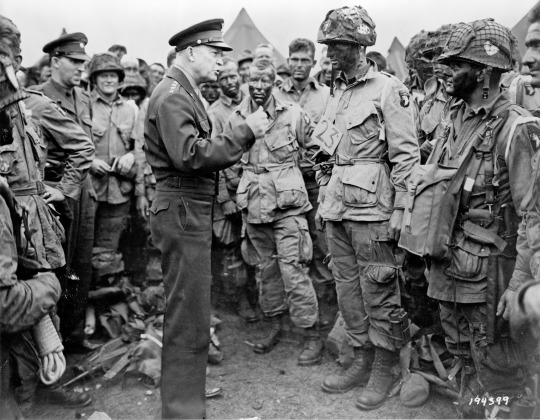
Supreme Allied Commander General Dwight D. Eisenhower speaks to men of the 101st Airborne prior to their boarding lanes that would take them to jump into Normandy. Eisenhower stayed at the airstrip until all of the planes had taken off safely before returning to his headquarters. Happily, casualties among the paratroopers were much lower than predicted. Of approximately 13,100 paratroopers who jumped into battle, approximately 2,500 (19%) were killed, wounded, or missing by the end of D-Day.
Approximately 3,000 landing craft and 2,500 ships were used during the invasion. Preliminary naval bombardment of German positions commenced at 05:45 and continued until 06:25 from five battleships, twenty cruisers, sixty-five destroyers, and two monitors. Infantry began arriving on the beaches at around 06:30.
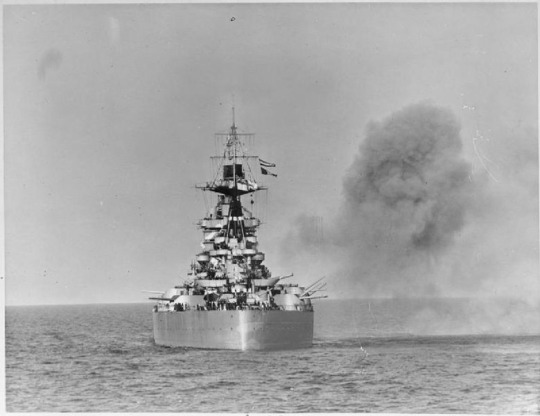



Above: (Top) The Battleship HMS Rodney fires on German positions at Caen, (Lower Left) Battleship USS Arkansas engages the enemy at Omaha Beach, (Lower Middle) Battleship USS Nevada fires her ten 14-inch guns in support of the Invasion, (Lower Right) Battleship USS Texas underway en route to England to participate in the Invasion.

Above: US Troops begin to establish a beachhead, signaling the beginning of the end of the Nazi occupation of Europe.
On D-Day, some 132,000 men were transported to the beaches by sea, and a further 24,000 entered France by air. The battlefield conditions were brutal and the Allied hold on the beaches was tenuous, particularly at Omaha Beach, the sector most heavily defended by German troops. But they held on. By July 25, 1944, the Allies had landed approximately 1.5 million troops in France and were ready to implement Operation Cobra, the Allied break out from Normandy. By the end of August, approximately 2,050,000 Allied troops had landed in France and resistance by Hitler’s Wehrmacht was crumbling.
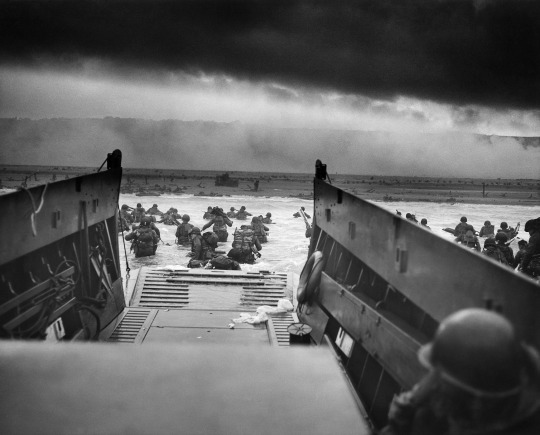
Above: US Troops exit a landing craft to attempt to establish a beachhead at Omaha Beach.
The Allies suffered approximately 226,000 casualties during the period from D-Day to the end of August: the American armies suffered 124,394 casualties, of whom 20,668 were killed, and 10,128 were missing. Casualties within the Canadian and British Armies are placed at 83,045: 15,995 killed, 57,996 wounded, and 9,054 missing.
During the same period, Allied air forces flew over 80,000 sorties in support of Operation Overlord, suffering approximately 17,000 additional casualties and the loss of over 4,000 aircraft.
They truly were the Greatest Generation. After what they did for all of us, it is only fitting that we pause for a moment to remember and reflect on the sacrifices they made at the altar of freedom.
#operation overlord#june 6 1944#d-day#general dwight d eisenhower#normandy#landing craft#airborne#paratroopers#101st airborne#82d airborne#thankful#grateful#respect#heroes
74 notes
·
View notes
Text
I recently made a connection that I can’t believe I hadn’t thought of before but I remembered that my great-grandfather was a private in the canadian expeditionary force during WW1 and he was a barber who cut soldiers’ hair while they were in england and france. and I was only recently like oh hey that’s very joe liebgott how did I not even make the comparison
8 notes
·
View notes
Text




Canadian WW1 drag performer Ross Hamilton as “Marjorie”
Ross Hamilton was born in Pugwash, Nova Scotia, in 1892. He enlisted in the Canadian Expeditionary Force in 1916 during the First World War. Ross first served as an ambulance driver before joining an all-male team of performing soldiers. Using a high falsetto singing voice, he played a female character on stage named Marjorie. The first outfits Ross put together were made from tent canvas, old curtains, pillow feathers and rosary beads.
Hamilton became a member of the famous vaudeville-style acting troupe, the Dumbells. For the rest of the war, Ross performed in shows for the troops. He and Marjorie were so popular he had to change out of costume before going back to the barracks for fear of being mobbed by fans.
As one soldier said, “When [Ross] marched into a mess in costume, every officer would stand to attention until he was seated. Then, in a truck driver’s voice, he’d call for a drink—and the illusion soon vanished!”
Ross volunteered for service when the Second World War broke out in 1939. Once again, he found himself entertaining soldiers as part of a group called “Chin up.” This time, his female character was a middle-aged opera singer. However, military authorities discovered that Ross was gay and discharged him from the army. Unfairly, members of the 2SLGBTQI+ community were officially barred from military service during the war years for no reason other than their sexual and gender identities.
Ross retired to a quiet life in a log cabin back in Nova Scotia to read, garden and help others in his home community. He died in 1965 at the age of 76 (source).
#i'm gonna make history posts sometimes if that's alright with you guys....#ww1#lgbt history#canadian history
5 notes
·
View notes
Text

Photograph of Victoria Cross winners, 5 December 1917. Left to right: Private Michael James O'Rourke of the 7th (1st British Columbia) Battalion, Canadian Expeditionary Force, awarded the Victoria Cross in France on 15/17 April 1917. Sergeant James Ockendon of the 1st Battalion, Royal Dublin Fusiliers, awarded the Victoria Cross in Belgium on 4 October 1917. Private William Boynton Butler of the 17th Battalion, West Yorkshire Regiment, awarded the Victoria Cross in France on 6 August 1917. Corporal Ernest Alfred Egerton of the 16th Battalion, Sherwood Foresters, awarded the Victoria Cross in Belgium on 20 September 1917.
7 notes
·
View notes
Text
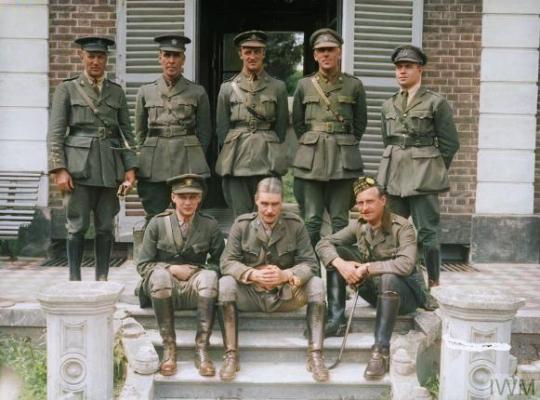
Officers of the Canadian Forestry Corps at their Headquarters, Conches-en-Ouche, 31st May 1917
#world war one#world war 1#historical photos#wwi#canadian history#CEF#canadian#Canada#Canadian expeditionary force#war history#military history#The Lost Generation#The wars#the Battle of the Somme#ww1#history#black history month#ww1 stories#ww1 portrait#The Great War#The First World War#1918#1917#1916#1914#Battle of the Somme
35 notes
·
View notes
Text

Close to 61,000 Canadians were killed during WWI, and another 172,000 were wounded. 619,636 Canadians enlisted with the Canadian Expeditionary Force during the war, and approximately 424,000 served overseas. (Estimated population in 1918: 8,148,000)
During WWII, approximately 1,159,000 Canadians served; the number of deaths totalled 44,090 and 54,000 were wounded. Approximately 700,000 Canadians under the age of 21 served in uniform during WWII. Estimated population in 1945: 12 million.
We owe them an immense debt of gratitude for the freedom we enjoy in Canada today.
14 notes
·
View notes
Text

"BURIAL OF GREAT WAR LEADER IN MONTREAL," Hamilton Spectator. December 6, 1933. Page 7.
---
Mourned by the whole of Canada, General Sir Arthur Currie, commander of the Canadian Expeditionary Force in the Great War, was laid at rest on Mount Royal yesterday afternoon. Top left shows a military escort presenting arms as the casket is placed on the gun carriage in front of the Arts building, McGill university. Top right are seen from left to right, John Currie, brother; Garnet Ormsby Currie, son, and A. T. Galt Durnford, son-in-law of General Currie. Lower left is seen a general view of the procession and crowd which thronged St. Catherine street in the vicinity of Christ Church cathedral, which appears in the background. Lower right are Lieut. Col. Lord Shaughnessy and Lieut. Allen Magee carrying General Currie's decorations in the procession following the gun carriage.
#montreal#canadian veterans#canadian expeditionary force#mount royal#funeral services#funeral procession#arthur currie#great depression in canada
0 notes
Text

CELEBRATING BLACK HISTORY 365: HARLEM HELLFIGHTERS
#blackhistory #africanamericanhistory #celebratingblackhistorymonth365
The 369th Infantry Regiment, formerly known as the 15th New York National Guard Regiment, was an infantry regiment of the New York Army National Guard during World War I and World War II. The Regiment consisted mainly of African Americans, though it also included a number of Puerto Rican Americans during World War II. It was known for being the first African American regiment to serve with the American Expeditionary Forces during World War I. Before the 15th New York National Guard Regiment was formed, any African American that wanted to fight in the war had to enlist in the French or Canadian armies.[2] The regiment was nicknamed the Harlem Hellfighters, the Black Rattlers, and the Men of Bronze, which was given to the regiment by the French.[3] The nickname "Hell Fighters" was given to them by the Germans due to their toughness and that they never lost a man through capture, lost a trench or a foot of ground to the enemy.]
62 notes
·
View notes